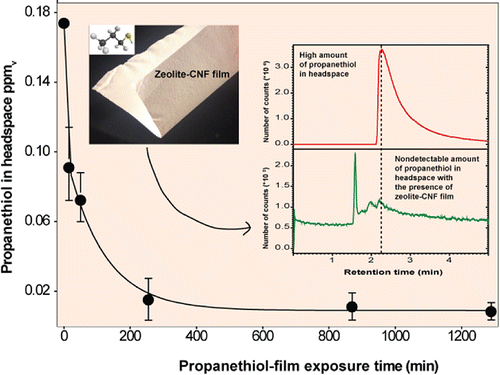Keeping the smells of onions, garlic and other stinky foods under wraps

Some of the world's most popular foods and seasonings can also be the smelliest—think garlic, onions, certain cheeses and the notoriously stinky Asian durian fruit. No amount of plastic wrap seems to contain their stench, but now scientists have developed a new film that could finally neutralize the odors of even the most pungent fare. They report their progress in the journal ACS Applied Materials & Interfaces.
The fetid smell of some foods makes it difficult to take them anywhere without offending others such as fellow train or bus riders. But tastes are growing more global, so scientists are looking for ways to transport and store reeking edibles without overpowering the senses of people nearby. They've tested some materials, but their success has been limited so far. Lennart Bergström and colleagues wanted to come up with a better packaging solution.
The researchers developed a film out of zeolites, which are microporous solids containing aluminum and silicon, and cellulose from wood. Testing the material showed that it could trap the sulfur-containing compounds often responsible for bad food smells. This adsorption reduced odors to levels below what humans can sniff out.
More information: Nanocellulose-Zeolite Composite Films for Odor Elimination, ACS Appl. Mater. Interfaces, 2015, 7 (26), pp 14254–14262. DOI: 10.1021/acsami.5b02252
Abstract
Free standing and strong odor-removing composite films of cellulose nanofibrils (CNF) with a high content of nanoporous zeolite adsorbents have been colloidally processed. Thermogravimetric desorption analysis (TGA) and infrared spectroscopy combined with computational simulations showed that commercially available silicalite-1 and ZSM-5 have a high affinity and uptake of volatile odors like ethanethiol and propanethiol, also in the presence of water. The simulations showed that propanethiol has a higher affinity, up to 16%, to the two zeolites compared with ethanethiol. Highly flexible and strong free-standing zeolite–CNF films with an adsorbent loading of 89 w/w% have been produced by Ca-induced gelation and vacuum filtration. The CNF-network controls the strength of the composite films and 100 μm thick zeolite–CNF films with a CNF content of less than 10 vol % displayed a tensile strength approaching 10 MPa. Headspace solid phase microextraction (SPME) coupled to gas chromatography–mass spectroscopy (GC/MS) analysis showed that the CNF–zeolite films can eliminate the volatile thiol-based odors to concentrations below the detection ability of the human olfactory system. Odor removing zeolite–cellulose nanofibril films could enable improved transport and storage of fruits and vegetables rich in odors, for example, onion and the tasty but foul-smelling South-East Asian Durian fruit.
Journal information: ACS Applied Materials and Interfaces
Provided by American Chemical Society



















